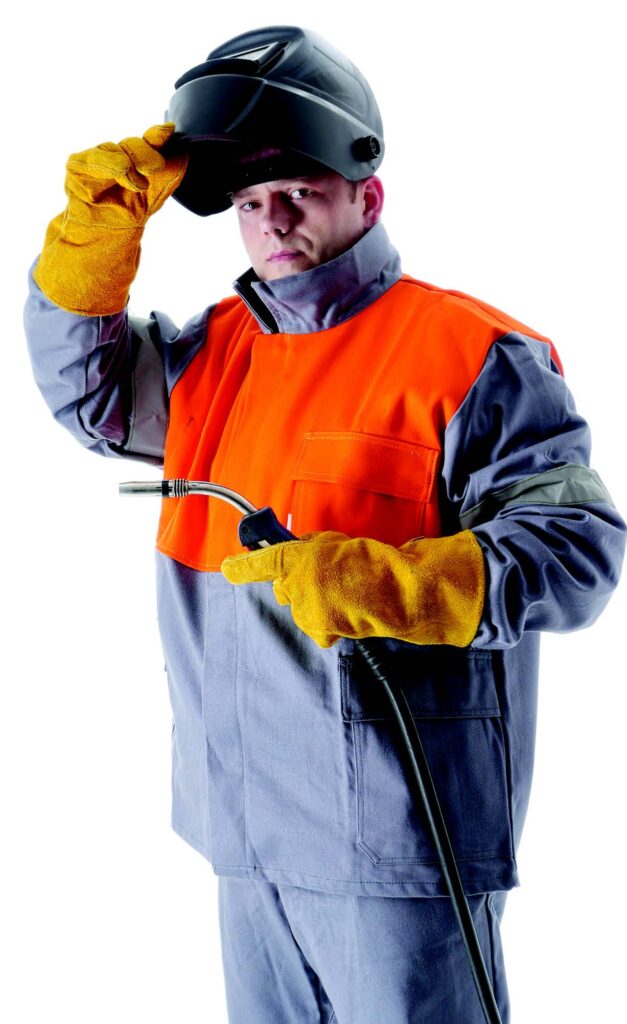Stainless steels are highly weldable, both to other stainless alloys and to other metals. This article briefly discusses the weldability of the different categories of stainless steel.
By A.K.Vaish, M.K. Mukherjee*, J.Krishnan*, B. J. Chauhan, S. D. Kahar, Ankit Bhojani and K M Bhaisaheb. Department of Metallurgical and Materials Engineering, The M.S.University of Baroda, India; *Larsen and Toubro Ltd., Hazira, Gujrat
Stainless alloys are highly weldable materials with welded joints providing optimum corrosion resistance, strength, and fabrication economy. Stainless steels are non-hardenable on cooling, so they exhibit good toughness without needing pre- or post-weld heat treatment. Stainless steel can be divided into five categories: ferritic, martensitic, austenitic, duplex (austenitic-ferritic) and precipitation hardening, based on the crystalline structure of their iron atoms. They have good weldability to other metals such as mild steel, medium and high carbon steel, galvanised steel, aluminium, copper etc.
Welding stainless steels
Stainless steel can be welded using TIG, Resistance and MIG welding.1
- TIG/gas tungsten arc welding
The most commonly used stainless steel welding process, TIG creates a low heat input, making it perfect for thin material. It offers high quality, versatility and longevity. To prevent oxidation and increase resistance to corrosion, a single-sided welding process can be used to create inert gas protection between the interior and exterior welds. Argon gas is often mixed with other gases, including helium, hydrogen and nitrogen. - Resistance/spot welding
Resistance or spot welding is one of the most economical types of welding. The welding equipment is incredibly versatile and can be used on small and large projects. This technology uses an electrical current to heat frayed metal edges and seal them together. It is useful on metal with a low melting point because it can be adjusted to prevent the distortion of metal. Resistance or spot welding is used on sheet metal products as the contacting metal surface points are joined by the heat obtained from resistance to electric current. - Mig /gas metal arc welding
Mig offers a strong joining of two pieces of stainless steel. It is a semi-automatic process utilising an argon-rich shielding gas and a solid wire electrode. Other gas mixtures, including those with helium, oxygen and carbon dioxide, are often used to stabilise the arc and improve weld quality. A pulsed current supply makes it easier to weld tough-to-reach spots on complex stainless steel projects.
In addition to having a minimum of 10.5% chromium, stainless steel is alloyed with other elements to improve heat resistance, mechanical properties and fabricating characteristics. These elements also modify and influence weldability.
Ferritic stainless steels
Ferritic stainless steels are considered to be predominantly single-phase and non-hardenable and can be readily fusion welded. At high temperatures, they undergo rapid grain growth leading to brittle heat-affected zones and have poor weldability. They are welded usually in thin sheets or sections of less than 6 mm thickness. Filler metals should match or exceed the chromium level of the base alloy. Ferritics are very suitable for use in welding especially in heat exchanger tubing because of their high thermal conductivity and low thermal expansion. Ferritics may crack during welding process due to excessive grain coarsening leading to poor toughness in the heat effected zone. No precaution is required for welding thin sections, however with thicker sections a low heat input can minimise the size of the grain coarsened zone and sensitivity to cracking2.
Martensitic stainless steels
Martensitics are vulnerable to cool cracking and do not weld easily as they may become hard and brittle upon cooling. They can be successfully welded provided precautions are taken to avoid cracking in the HAZ, especially in thick section components and highly restrained joints. High hardness in the HAZ makes this type of stainless steel prone to hydrogen cracking. The weld gets completely transformed to untempered martensite by allowing the joint to cool to room temperature. Such steels should be welded with careful precautions. The risk of cracking generally increases with the carbon content and it can be combated by utilising a low hydrogen welding process such as TIG or MIG, or by using hydrogen-controlled fillers. The pre- and post-weld treatments, especially for thicker sections and higher carbon materials, may help to toughen the structure, enable the hydrogen to diffuse from the weld metal, and reduce the risk of cracking.3 The filler metals should match the chromium and carbon content of base martensitic metal. Type 410 filler is used to weld types 402, 410, 414 and 420 steels. However, some martensitic grades of stainless steel are considered near impossible to weld.
Austenitic stainless steels
These steels can be readily welded using any of the arc welding processes (TIG, MIG, MMA and SA). As they are non-hardenable on cooling, they exhibit good toughness with no need for pre- or post-weld heat treatment. Austenitics fall in the 200 and 300 series of stainless steel alloys and are highly resistant to corrosion and extremely malleable. Normally fillers with matching composition to the base material are used.
Duplex (austenitic-ferritic) steels
 The weldability and welding characteristics of duplex stainless steels are better than those of ferritic steels, although not generally as good as austenitic steels. Modern duplexes with significant nitrogen content are readily weldable. During welding one must be very careful with temperatures since too little or too much heat can compromise the structural integrity of the steel. Selecting a filler metal is slightly more challenging. Many types of duplex stainless base metals are not available as filler metals since filler metal cools much more quickly than the base metal.
The weldability and welding characteristics of duplex stainless steels are better than those of ferritic steels, although not generally as good as austenitic steels. Modern duplexes with significant nitrogen content are readily weldable. During welding one must be very careful with temperatures since too little or too much heat can compromise the structural integrity of the steel. Selecting a filler metal is slightly more challenging. Many types of duplex stainless base metals are not available as filler metals since filler metal cools much more quickly than the base metal.
Precipitation hardening stainless
Precipitation-hardening stainless steels are a combination of martensitic and austenitic stainless steels.
They are resistant to corrosion and capable of being hardened through heat. They possess above-average weldability. They can be hardened through heat treatment to levels comparable to martensitic steel while having similar corrosion resistance to austenitics. Although the weldability of precipitation-hardening stainless steel is not on par with the weldability of austenitic stainless steel, it is very good. They can be welded without preheating but must be heated after the weld has been completed to preserve its structural integrity. Precipitation hardening stainless steels can be readily welded through standard fusion and resistance methods; however, special care should be taken during heat treatment process to ensure the optimum mechanical properties for weldability are achieved. Achieving the same mechanical properties in the weld as in parent material is difficult for precipitation hardening steels. Careful preparation is required to utilise the matching filler and heat treatment after welding can be used to help the weld achieve close similarities to the parent metal.
Weldability to mild/low carbon steel
Carbon in mild steel typically ranges from 0.05% to 0.25% by weight. Welding of stainless to mild steel is not difficult as the two metals have almost the same properties. MIG welding or GMAW is an excellent process to weld stainless to mild steel. Selecting the proper wire is important; the best filler metal is 3094 which has a low carbon content and a small amount of ferrite to prevent cracking. Grade 309 has enough chromium and nickel to counter the mild steel dilution problem. As a result, the deposited weld metal will have excellent corrosion resistance.
Medium & high carbon steel
Medium-carbon steel consists of 0.30% to 0.60% carbon, whereas high-carbon steel contains more than 0.60%. As the carbon content increases, the steel becomes stronger, harder, and less ductile.
- Medium carbon steels containing 0.30-0.60% carbon and 0.60-1.65%manganese are stronger than low carbon steel but are more difficult to weld as they are more prone to cracking. Weld using a low-hydrogen welding process or controlled hydrogen fillers.
- High-carbon steels containing 0.60-1.0% carbon and 0.30-0.90% manganese are extremely hard and strong, but have poor weldability and are difficult to weld without cracking.
Medium and high carbon steels are typically considered ‘hard to weld’ because of the hardening effect of heat at the welded joint. As the steel cools, they may readily form the hard and brittle martensite phase. Because of the high carbon content and the heat treatment usually given to these steels, their basic properties are impaired by arc welding. Therefore these steels will most likely require very thorough preheating and post-heating processes. Austenitics such as grade 304 or grade 316 can be welded to plain carbon steel using MIG and TIG welding. When welding stainless to plain carbon steel by MIG welding process, the use of filler material is preferred5.
Weldability to galvanised steel
When welding stainless steel to galvanised steel, the zinc coating around the area to be joined should be removed beforehand. If molten zinc is present in the weld fusion zone it can result in embrittlement or reduced corrosion resistance of the finished weld.6
Weldability to aluminium
Welding aluminium and steel is utilised in the aerospace, automotive and shipbuilding industries to reduce weight and enhance efficiency.
There is a huge difference in melting points of aluminium and steel, a great disadvantage for the process. Two techniques were developed to isolate the metals from each other during
the arc welding process to avoid the formation of very brittle intermetallic compounds.
- The first uses bimetallic transitions, where aluminium and stainless steel are joined by methods that do not create the compounds. This allows the joining of the two metals by only welding aluminium to aluminium and stainless steel to stainless steel.
- The second is to coat the stainless steel with aluminium or silver solder and arc weld the aluminium to that instead.7
Weldability to copper
Electron beam welding is the preferred welding process for this, mainly because it is a great process for welding copper, which is the more challenging of the two metals to weld. Welding copper and stainless together is extremely difficult and offers very little structural strength.8
Conclusion
Welding stainless steel is not significantly different to welding standard carbon steel. However, one must exercise more care and control concerning heating and cooling stainless steel, and it is important to properly match the filler metals with the material being welded.
 Dr Ashok K Vaish is President of the Aryabhata Newton International Research and Educational Foundation (ANIREF) and, until recently, was the Ministry of Steel Chair Professor at the MS University of Baroda, India.
Dr Ashok K Vaish is President of the Aryabhata Newton International Research and Educational Foundation (ANIREF) and, until recently, was the Ministry of Steel Chair Professor at the MS University of Baroda, India.
References:
- https://www.atwf-inc.com/blog/3-common-methods-for-welding-stainless-steel
- https://adslaser.co.uk/what-are-the-5-types-of-stainless-steel/
- https://www.onlinemetals.com/weldability-of-stainless-steel
- https://www.materialwelding.com/how-to-weld-stainless-steel-to-mild-steel/#:~:text=Simple%20Answer%2D%20YES.,not%20suitable%20for%20heat%20treatment.
- https://www.marlinwire.com/blog/welding-carbon-and-stainless-steel#:~:text=Austenitic%20stainless%20steels%20such%20as,use%20filler%20material%20are%20preferred.
- https://bssa.org.uk/bssa_articles/welding-stainless-steels-to-other-steels/#:~:text=When%20welding%20stainless%20steels%20to,resistance%20of%20the%20finished%20weld
- https://weldingmastermind.com/how-to-tig-weld-aluminum-to-stainless-steel-the-full-guide/
- https://learntomoonshine.com/how-to-solder-braze-and-weld-stainless-steel-to-copper/#:~:text=So%20can%20copper%20and%20stainless,offers%20very%20little%20structural%20strength
About this Featured Story
This Featured Story appeared in Stainless Steel World November 2022 magazine. To read many more articles like these on an (almost) monthly basis, subscribe to our magazine (available in print and digital format – SUBSCRIPTIONS TO OUR DIGITAL VERSION ARE NOW FREE) .
Want to contribute as author? Please contact Joanne.
Every week we share a new Featured Story with our Stainless Steel community. Join us and let’s share your Featured Story on Stainless Steel World online and in print.


